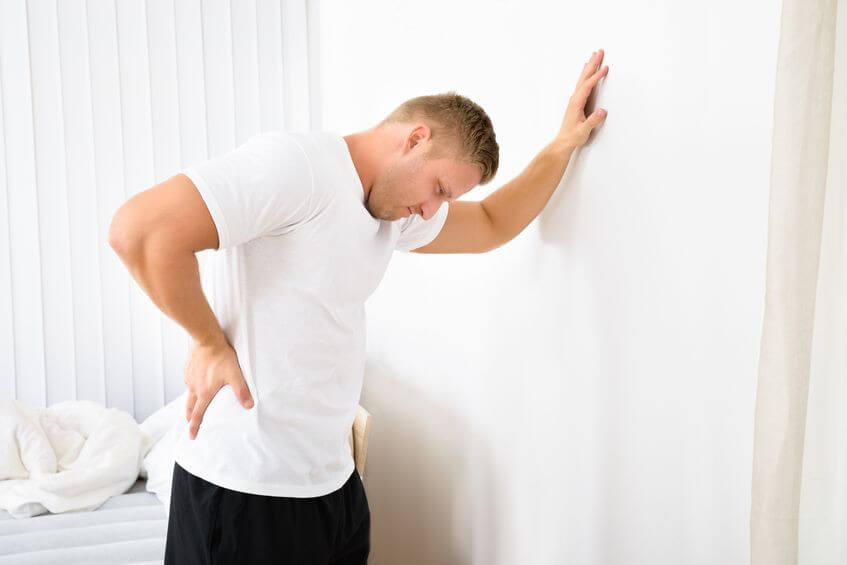You can listen to Sarah’s podcast on this topic here:
El reflejo flexor y el dolor unilateral
El reflejo flexor y la recuperación de lesiones
Imagínese que se resbaló en los escalones helados de la entrada y se torció el tobillo. Además del hecho de que no tiene una historia emocionante de montañismo que contar, debe usar una tobillera y muletas durante al menos un mes para que los ligamentos rotos puedan sanar. Tienes que poner todo tu peso sobre tu lado sano, e instintivamente contraes e inmovilizas el lado lesionado para protegerlo.
Durante las próximas cuatro semanas, se vuelve realmente bueno cojeando con su única pierna buena. Esta forma antinatural de moverse comienza a volverse habitual. Incluso después de que su tobillo esté completamente curado, se encontrará de pie con su peso desplazado hacia un lado y la otra cadera levantada.
El reflejo flexor y el dolor crónico
Ahora imagine que tiene un dolor crónico en el hombro derecho. Le diagnostican un desgarro del manguito rotador, resultado de años de desgaste por el levantamiento de pesas. A medida que aumenta el dolor, utiliza cada vez menos el hombro para evitarlo. También desarrolla la tendencia a sostener su brazo derecho contra su cuerpo para limitar el movimiento de su hombro.
Después de la cirugía y meses de fisioterapia, su dolor finalmente desaparece, pero su patrón de movimiento habitual permanece. Los músculos que sostienen su hombro en su lugar y tiran de su brazo hacia su cuerpo están crónicamente contraídos, y su hombro derecho está ahora una pulgada más bajo que el izquierdo.
Las formas en que ajustamos nuestra postura y movimiento en reacción a una lesión o dolor crónico son en gran parte subconscientes. Contraemos ciertos músculos para proteger el área dolorida o lesionada y modificamos nuestros patrones de movimiento para evitar el dolor. Nuestro sistema de procesamiento del dolor funciona con nuestros sistemas propioceptivo y vestibular para ajustar automáticamente nuestra postura y movimiento para que podamos minimizar nuestro dolor y prevenir más lesiones.
¿Qué es el Flexor Reflex?
When one side of the body is injured or feels pain, such as when we step on a nail or touch a very hot pan, an automatic nervous system response called the flexor reflex is triggered. The flexor muscles on the injured side of the body contract to pull the affected area away from the source of pain. Then the crossed-extensor reflex immediately kicks in, activating the extensor muscles on the opposite side of the body so that our weight remains balanced and we don’t fall over.
The flexor reflex is extremely helpful during acute pain or injury because it helps us avoid pain and further damage to our body. However, when it is activated constantly by chronic pain or a prolonged healing process from an injury, we can easily develop muscular patterns that stay with us permanently. What begins as a protective postural mechanism becomes a habitual muscular pattern, causing misalignment, dysfunctional movement, and further pain.
Esta respuesta reflexiva y protectora a la lesión siempre se experimentará en un lado, a menos que nuestra lesión o dolor esté directamente en el centro de nuestro cuerpo, como en el abdomen o en la columna vertebral. Por ejemplo, después de una cirugía abdominal tendemos a estar de pie con una postura redondeada para proteger nuestro abdomen, que efectivamente ha pasado por un trauma. Del mismo modo, si nuestra columna se lesiona, los músculos de la espalda se tensarán para limitar el movimiento.
Aliviar los efectos negativos del reflejo flexor
Thomas Hanna, who developed Clinical Somatic Education, observed the effects of the flexor reflex in his clients. They had tilted and often rotated posture, uneven hips and shoulders, and different patterns of muscular contraction on each side of the body. Many of these clients had , sciatica, or pain in their hip, knee, and ankle joints, while others had frozen shoulder, bursitis, or carpal tunnel syndrome.
Some of Hanna’s clients had even been told by doctors that they had one leg longer than the other. This perceived difference in leg length was caused by tight waist muscles hiking one hip up higher than the other. When Hanna taught his clients how to release their oblique muscles, their hips evened out and miraculously, their legs were the same length.
If you’ve read the other two posts in this series, and learned about the effects of the action response, withdrawal response, and now the flexor reflex, you will likely find it difficult not to notice them in everyone you see. You’ll be able to tell who among your friends has back pain simply by observing their tight, arched lower backs. You’ll observe strangers on the street hunched over, their backs and shoulders rounded and their heads sticking forward. You may even look in the mirror and see that one of your shoulders or hips is higher than the other. Don’t worry—these are all functional issues that can be improved and eliminated with the methods of Clinical Somatic Education.
Consulte las otras dos publicaciones de esta serie sobre reflejos y postura:
Cómo la respuesta de acción conduce al dolor de espalda
Cómo la respuesta de abstinencia conduce a una postura redondeada
Lectura recomendada:
The Pain Relief Secret: How to Retrain Your Nervous System, Heal Your Body, and Overcome Chronic Pain by Sarah Warren, CSE
Somatics: Reawakening the Mind’s Control of Movement, Flexibility and Health by Thomas Hanna

